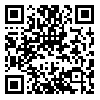BibTeX | RIS | EndNote | Medlars | ProCite | Reference Manager | RefWorks
Send citation to:
URL: http://jdisabilstud.org/article-1-3141-en.html
2- Associate Professor, Department of Psychology, Tonekabon Branch, Islamic Azad UniversityTonakabon, Iran & Department of Psychology, Science and Arts University, Yazd, Iran
3- Associate Professor, Department of Psychology, Tonekabon Branch, Islamic Azad University, Tonakabon, Iran & Department of Psychology, University of Tehran, Tehran, Iran
Abstract
Background & Objectives: Attention–deficit/hyperactivity disorder (ADHD) is a neurodevelopmental disorder associated with certain types of behavioral and neurological problems. Working memory deficits are present in most children with ADHD. Working memory refers to the active, top–down manipulation of information in short–term memory. Attention deficit is one of the symptoms associated with ADHD. Attention is conscious concentration on a phenomenon to the exclusion of other stimuli. Until now, various drug and non–drug treatments could not introduce a golden standard of treatment in ADHD children. Considering the high prevalence of ADHD children and their many neurological and behavioral problems, which can endanger their future both academically and professionally, new and diverse treatment techniques are needed to help them. Therefore, this study aimed to investigate the effectiveness of transcranial direct current brain stimulation on working memory and attention in children with ADHD.
Methods: This quasi–experimental study employed a pretest–posttest design with a control group. Among children aged 6 to 9 years with symptoms of ADHD referred to psychology and psychiatry clinics in Yazd City, Iran, 30 qualified volunteers were randomly chosen and included in the study. Then, 15 were randomly assigned to the intervention group and 15 people in the control group. The inclusion criteria were as follows: having ADHD with a psychiatrist's approval, age range of 6 to 9 years, not using other treatment methods such as behavioral therapy and drug therapy, and lacking motivation of the child's family to participate in the research. In both groups, in the pretest and posttest stages, the variable of working memory was evaluated with the Working Memory Test (Damin & Carpenter, 1980), and the variable of attention was assessed using the Test of Everyday Attention (Robertson et al., 1996). Data analysis was done using covariance analysis in SPSS 17. The significance level of the tests was set at 0.05.
Results: Data analysis showed that the mean scores of active memory and attention tests in children with ADHD in the intervention group and after treatment increased significantly compared to the control group (p<0.001). Based on the effect size results, 58% of the difference between the intervention group and the control group in the variable of working memory was due to the transcranial direct current stimulation of the brain. This amount for the attention intensity variable was 54%.
Conclusion: The results of the present study showed that transcranial direct current stimulation of the brain could be used as a complementary therapy to improve working memory and attention in children with attention–deficit/hyperactivity disorder.
| Rights and permissions | |
 |
This work is licensed under a Creative Commons Attribution-NonCommercial 4.0 International License. |



